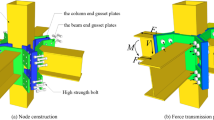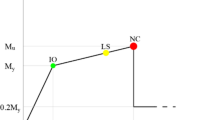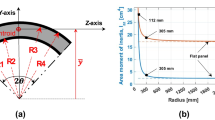Abstract
This paper attempts to study the seismic behavior of tall unstiffened steel plate shear wall (SPSW) systems with an emphasis on the higher-mode pushover analysis and to elaborate the relevant pushover curve. Improved pushover analyses (IPAs) including the modal pushover analysis (MPA) and the modified modal pushover analysis (MMPA) are used for the frames in which the higher-mode effects are substantially important. The conventional pushover analysis using the FEMA load distributions is also implemented. To achieve this goal, mid-rise (10 and 15-story) and high-rise (20 and 30-story) SPSW systems are investigated. To consider a detailed behavior of SPSWs in analyses, a three-dimensional (3D) finite element modeling is used. An interesting result is obtained that the higher-mode pushover analysis results in a reversal in the pushover curve for all of the unstiffened SPSW systems studied in this investigation that this phenomenon is rare in performance-based seismic engineering. The results provide evidence that among the above-mentioned pushover analyses, the MPA procedure is accurate enough for the seismic evaluation of tall SPSW systems. Furthermore, the MPA is computationally time efficient in comparison with the nonlinear response history analysis for this kind of structures with 3D finite element modeling in which there exist a large number of frame and shell elements.

















Similar content being viewed by others
References
Astaneh-Asl A (2000) Steel plate shear walls. In: Proceedings, U.S.-Japan partnership for advanced steel structures, U.S.-Japan workshop on seismic fracture issue in steel structures, February 2000, San Francisco
Astaneh-Asl A (2001) Seismic behavior of steel plate shear walls. Steel tips report. Structural Steel Education Council, Moraga
Berman JW, Vian D, Bruneau M (2005) Steel plate shear walls-from research to codification. In: Proceeding of the ASCE 2005 structures congress
Kang THK, Martin RD, Park HG, Wilkerson R, Youssef N (2011) Tall building with steel plate shear walls subject to load reversal. Struct Des Tall Spec Build. https://doi.org/10.1002/tal.700
Youssef N, Wilkerson R, Fischer K, Tunick D (2010) Seismic performance of a 55-storey steel plate shear wall. Struct Des Tall Spec Build 19(1–2):139–165
Arslan H, Topkaya C (2010) A numerical study on response factors for steel wall-frame systems. Earthq Eng Struct Dyn 39(14):1611–1630
Wang M, Shi Y, Xu J, Yang W, Li Y (2015) Experimental and numerical study of unstiffened steel plate shear wall structures. J Constr Steel Res 112:373–386
Zirakian T, Zhang J (2015) Structural performance of unstiffened low yield point steel plate shear walls. J Constr Steel Res 112:40–53
Yang Lv Zhong-xian, Li, (2016). Influences of the gravity loads on the cyclic performance of unstiffened steel plate shear wall. Struct Des Tall Spec Build 25(17):988–1008
Jalali SA, Banazadeh M (2016) Development of a new deteriorating hysteresis model for seismic collapse assessment of thin steel plate shear walls. Thin Wall Struct 106:244–257
Mashhadiali N, Gholhaki M, Kheyroddin A, Zahiri-Hashemi R (2016) Analytical evaluation of the vulnerability of framed tall buildings with steel plate shear wall to progressive collapse. Int J Civil Eng 14(8):595–608
American Society of Civil Engineers (ASCE) (2010) Minimum design loads for buildings and other structures. ASCE7-10, Reston
AISC, ANSI/AISC341-05 (2005) Seismic provisions for structural steel buildings. American Institute of Steel Construction, Chicago
Krawinkler H, Seneviratna GDPK (1998) Pros and cons of a pushover analysis of seismic performance evaluation. Eng Struct 20(4–6):452 62
Chopra AK, Goel RK (2002) A modal pushover analysis procedure for estimating seismic demands for buildings. Earthq Eng Struct Dyn 31:561_82
Sasaki KK, Freeman SA, Paret TF (1998) Multi-mode pushover procedure (MMP)—a method to identify the effects of higher modes in a pushover analysis. In: Proceedings of 6th US nat. conf. on earthq. Eng., seattle (Washington)
Moghadam AS (2002) A pushover procedure for tall buildings. In: Proceeding 12th European conference on earthquake engineering. Elsevier Science Ltd, London (United Kingdom), paper 395
Chopra AK, Goel RK, Chintanapakdee C (2004) Evaluation of a modified MPA procedure assuming higher modes as elastic to estimate seismic demands. Earthq Spectra 20(3):757–778
Jan TS, Liu MW, Kao YC (2004) An upper-bound pushover analysis procedure for estimating the seismic demand of high-rise buildings. Eng Struct 26:117–128
Antoniou S, Pinho R (2004) Advantages and limitations of adaptive and non-adaptive force-based pushover procedures. J Earthq Eng 8(4):497–522
Antonio S, Pinho R (2004) Development and verification of a displacement-based adaptive pushover procedure. J Earthq Eng 8(5):643–661
Kalkan E, Kunnath SK (2006) Adaptive modal combination procedure for nonlinear static analysis of building structures. ASCE J Struct Eng 132(11):1721–1731
Kim S-P, Kurama YC (2008) An alternative pushover analysis procedure to estimate seismic displacement demands. Eng Struct 30:3793–3807
Poursha M, Khoshnoudian F, Moghadam AS (2009) A consecutive modal pushover procedure for estimating the seismic demands of tall buildings. Eng Struct 31:591–599
Shakeri K, Shayanfar MA, Kabeyasawa T (2010) A story shear-based adaptive pushover procedure for estimating seismic demands of buildings. Eng Struct 32:174–183
Kreslin M, Fajfar P (2011) The extended N2 method taking into account higher mode effects in elevation. Earthq Eng Struct Dyn 40(14):1535–1651
Sucuoğlu H, Günay MS (2011) Generalized force vectors for multi-mode pushover analysis. Earthq Eng Struct Dyn 40(1):55–74
Rofooei FR, Mirjalili MR, Attari NKA (2012) Modal spectra combination method for pushover analysis of special steel moment resisting frames. Int J Civil Eng 10(4):245–252
Abbasnia R, Tajik Davoudi A, Maddah MM (2013) An adaptive pushover procedure based on effective modal mass combination rule. Eng Struct 52:654–666
Poursha M, Amini MA (2015) A single-run multi-mode pushover procedure to account for the effect of higher modes in estimating the seismic demands of tall buildings. Bull Earthq Eng 13(8):2347–2365
Amini MA, Poursha M (2016) A non-adaptive displacement-based pushover procedure for the nonlinear static analysis of tall building frames. Eng Struct 126:586–597
Zhang JZ, Jiang J, Li GQ (2017) An improved consecutive modal pushover procedure for estimating seismic demands of multi-storey framed buildings. Soil Dyn Earthq Eng 26:4
Vafaee MH, Saffari H (2017) A modal shear-based pushover procedure for estimating the seismic demands of tall building structures. Soil Dyn Earthq Eng 92:95–108
Esfahanian AR, Aghakouchak AA (2017) A single-run dynamic based approach for pushover analysis of structures subjected to near-fault pulse-like ground motions. J Earthq Eng. https://doi.org/10.1080/13632469.2017.1326420
Mirjalili MR, Rofooei FR (2017) The modified dynamic-based pushover analysis of steel moment resisting frames. Struct Des Tall Spec Build. https://doi.org/10.1002/tal.1378
Balic I, Trogrlic B, Mihanovic A (2017) Simplified multimodal pushover target acceleration method for seismic resistance analysis of medium-rise RC structures. KSCE J Civil Eng. https://doi.org/10.1007/s12205-016-0738-4
Fragiadakis M, Vamvatsikos D, Aschheim M (2014) Application of nonlinear static procedures for the seismic assessment of regular RC moment frame buildings. Earthq Spectra 30(2):767–794
Building Seismic Safety Council (BSSC) (2000) Pre-standard and commentary for the seismic rehabilitation of buildings. FEMA-356. Federal Emergency Management Agency, Washington (DC)
Goel RK, Chopra AK (2005) Role of higher-“mode” pushover analysis in seismic analysis of buildings. Earthq Spectra 21(4):1027–1041
ANSYS (2009) ANSYS version 12.1, ANSYS user’s manual. ANSYS, Inc, Canonsburg
Behbahanifard MR, Grondin GY, Elwi AE (2003) Experimental and numerical investigation of steel plate shear wall. Structural engineering report no. 254. Department of Civil and Environmental Engineering, University of Alberta, Canada
Driver RG, Kulak GL, Kennedy DJL, Elwi AE (1997) Seismic behavior of steel plate shear walls. Structural engineering report 215. University of Alberta, Canada
Topkaya C, Atasoy M (2009). Lateral stiffness of steel plate shear wall systems. Thin Wall Struct 47(8–9):827–835
Kurban CO, Topkaya C (2009) A numerical study on response modification, overstrength, and displacement amplification factors for steel plate shear wall systems. Earthq Eng Struct Dyn 38:497–516
Kurban CO (2009) A numerical study on response factors for steel plate shear wall systems. MSc Thesis, Middle East Technical University
EN10025 (1994) Hot rolled products of non-alloy structural steel. CEN, European Committee for Standardization, Brussels
Topkaya C, Kurban CO (2009) Natural periods of steel plate shear wall systems. J Constr Steel Res 65:542–551
Rezai M (1999) Seismic behavior of steel plate shear walls by shake table testing. Ph.D Dissertation, Department of Civil Engineering, University of British Columbia, Vancouver, Canada
Liu Y (2008) ANSYS and LS-DYNA used for structural analysis. Int J Comput Aid Eng Technol 1:1
Funding
No funding Information available.
Author information
Authors and Affiliations
Corresponding author
Appendix
Appendix
Modal properties of inelastic SDF systems derived from modal pushover analysis (MPA) are provided in Table 4. Table 5 gives the target displacements for the higher modes in the MMPA procedure.
Rights and permissions
About this article
Cite this article
Kosari, E., Poursha, M. & Abedi, K. Seismic Evaluation of Tall Unstiffened Steel Plate Shear Wall (SPSW) Systems with Emphasis on Reversal Phenomenon in the Higher Mode Pushover Curve. Int J Civ Eng 17, 523–540 (2019). https://doi.org/10.1007/s40999-018-0286-z
Received:
Revised:
Accepted:
Published:
Issue Date:
DOI: https://doi.org/10.1007/s40999-018-0286-z




